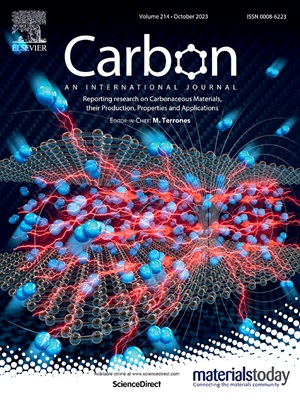Hollow engineering of carbon-based microspheres: Microstructural modulation for advanced electromagnetic wave absorption
IF 10.5
2区 材料科学
Q1 CHEMISTRY, PHYSICAL
引用次数: 0
Abstract
Electromagnetic (EM) absorption is becoming a progressive strategy to address the concerns in the fields of EM pollution, information security, and military stealth. In addition to the composition of EM wave absorbing materials (EWAMs), the design of morphology and microstructure has also been evolved into another core topic for optimizing their performance, because it directly affects their impedance matching, loss mechanism, response bandwidth, and environmental adaptability. As one kind of promising candidates, hollow carbon-based microspheres (HCBMs) have been intensively studied in the past decade, not only for their diverse composition, tunable EM characteristics, and profitable hollow cavity, but also for their uniform size and good dispersion, offering a great opportunity for the fabrication of customized structural-functional integrated materials through additive manufacturing. In this review, we introduce some mature and emerging route for HCBMs, including hard template, post-modification, spray drying, self-assembly, and heterogeneous contraction resistance, and highlight the advances of the resultant HCBMs in EM absorption. Moreover, some challenges and prospects are also proposed from the perspective of current research progress, and we hope this review may inspire further development of HCBMs.

碳基微球中空工程:先进电磁波吸收的微结构调制
电磁吸收已成为解决电磁污染、信息安全和军事隐身等领域问题的一种进步策略。除了电磁波吸收材料的组成外,形貌和微观结构的设计也成为优化其性能的另一个核心课题,因为它直接影响到电磁波吸收材料的阻抗匹配、损耗机制、响应带宽和环境适应性。作为一种很有前途的候选材料,空心碳基微球(HCBMs)在过去的十年中得到了广泛的研究,不仅因为其多样化的成分、可调谐的EM特性和有利的空心腔,而且由于其均匀的尺寸和良好的分散性,为通过增材制造制造定制结构功能集成材料提供了很大的机会。本文综述了几种成熟的和新兴的HCBMs制备途径,包括硬模板、后改性、喷雾干燥、自组装和抗异质收缩等,并重点介绍了制备的HCBMs在电磁吸收方面的研究进展。并从目前研究进展的角度,提出了一些挑战和展望,希望对HCBMs的进一步发展有所启发。
本文章由计算机程序翻译,如有差异,请以英文原文为准。
求助全文
约1分钟内获得全文
求助全文
来源期刊

Carbon
工程技术-材料科学:综合
CiteScore
20.80
自引率
7.30%
发文量
0
审稿时长
23 days
期刊介绍:
The journal Carbon is an international multidisciplinary forum for communicating scientific advances in the field of carbon materials. It reports new findings related to the formation, structure, properties, behaviors, and technological applications of carbons. Carbons are a broad class of ordered or disordered solid phases composed primarily of elemental carbon, including but not limited to carbon black, carbon fibers and filaments, carbon nanotubes, diamond and diamond-like carbon, fullerenes, glassy carbon, graphite, graphene, graphene-oxide, porous carbons, pyrolytic carbon, and other sp2 and non-sp2 hybridized carbon systems. Carbon is the companion title to the open access journal Carbon Trends. Relevant application areas for carbon materials include biology and medicine, catalysis, electronic, optoelectronic, spintronic, high-frequency, and photonic devices, energy storage and conversion systems, environmental applications and water treatment, smart materials and systems, and structural and thermal applications.
 求助内容:
求助内容: 应助结果提醒方式:
应助结果提醒方式:


